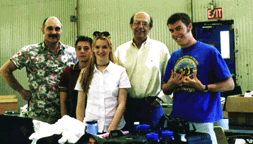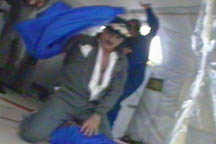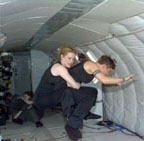|
|
 |
 |
 |
|
Research Project Number 33 enabled Elizabeth Allbee Abascal, Clovis
Blackwell, Frank Pietronigro and Kris Shapiro to climb aboard NASA's
KC135 turbojet to engage in scientific and creative investigations while
their bodies floated in mid-air.
As a counterpoint to free-float, their bodies also experienced 2G forces
at the bottom end of the parabolic arc, which doubled their body weight,
for forty-five to fifty seconds while the jet repositioned itself for
the next parabola. Microgravity served the artists as an environmental
contributing factor to the development of their art work within the
context of a new and unique weightless studio.
The National Space Grant College and Fellowship Program was authorized
by Congress in 1987 to increase the understanding, assessment,
development, and use of space resources. The National Space Grant
Consortium provides awarded students across the country with the
opportunity to experience and conduct experiments in a true
three-dimensional "weightless" environment at the Johnson Space
Center's Reduced Gravity Program.
The NASA Reduced Gravity Student Flight Program allowed up to 48
undergraduate student teams, in 1998, to propose, design, fabricate, fly
and assess a reduced-gravity experiment of their choice. Some of the
other 48 educational institutions awarded the opportunity to fly in 1998
include: Massachusetts Institute of Technology, Princeton University,
Purdue University, and Embry-Riddle Aeronautical University.
Research Project Number 33 was created by Frank Pietronigro, in part, so
that artists could also gain access to research technologies
traditionally the province of only astronauts and scientists. What
would evolve out of this collaborative partnership is basic scientific
data, fine art, post-process objects, dance, choreography, video
documentation, photography, and film.
Our playful investigations, as preliminary research into new
possibilities, may inspire interesting forms of creative expression
which we hope will support the quality of life for all future space
travelers. Such forms become possible because of a unique dialogue
between artists within the technological space of the astronaut. |
|
 |
 |
|
CLOVIS BLACKWELL
Clovis visually studied fluid behaviors and fluid dynamcis during periods of microgravity. Using Super 8 film he documented these behaviors and will later edit the images with others. Some of the themes Clovis conveys in his work are the human curiosity of the unknown
emphasizing exploration into the sky we have all looked up into, and the hesitation of some to venture to new worlds, including physical, emotional and spiritual. Clovis' influences for these ideas come from his relationships with and his deep love for his friends, family and his heavenly father. Clovis is very excited to be included in this team on a journey to explore the new horizons of artistic experience whileemploying scientific research methods. |
|
|
 |
 |
 |
|
Frank Pietronigro then employed traditional modernist painting conventions,
similar to "action painting" in order to eliminate the traditional
painting support, the canvas, and to study of fluid dynamics of acrylic
paints in microgravity. He compared their drift, adhesion and control
of movement or lack thereof to the adhesion and control of acrylic
paints as he experienced in a gravity based environment. Frank observed
the oscillatory behavior of acrylic materials, comprised of the
viscosity of toothpaste and compared those materials to acrylic
materials having the viscosity of table cream. As a modification of
these baseline experiments, iron filaments, stainless steel, and diamond
dust were added into the paints in order for the artist to understand
how their behavior would change with the introduction of magnetic wands
during free-float.
10", 14" and 18" pastry bags were filled with thick acrylic gel medium
by the artist before flight. The thick acrylic paint was then projected into an enclosed vinyl container, erected aboard the KC135, during the last twenty parabolic maneuvers. |
|
 |
 |
|
Kris Shapiro is a multidisciplinary artist whose photo-based work concentrates on the human body. Although primarily a photographer, her examination of the human form, both interior and exterior, incorporates modern dance and martial arts.
She trained in trapeze arts while attending NYU. She choreographed an original dance piece which she performed in microgravity. Both the dance itself and the photographs that resulted will be incorporated into her final work. |
|
|
|




